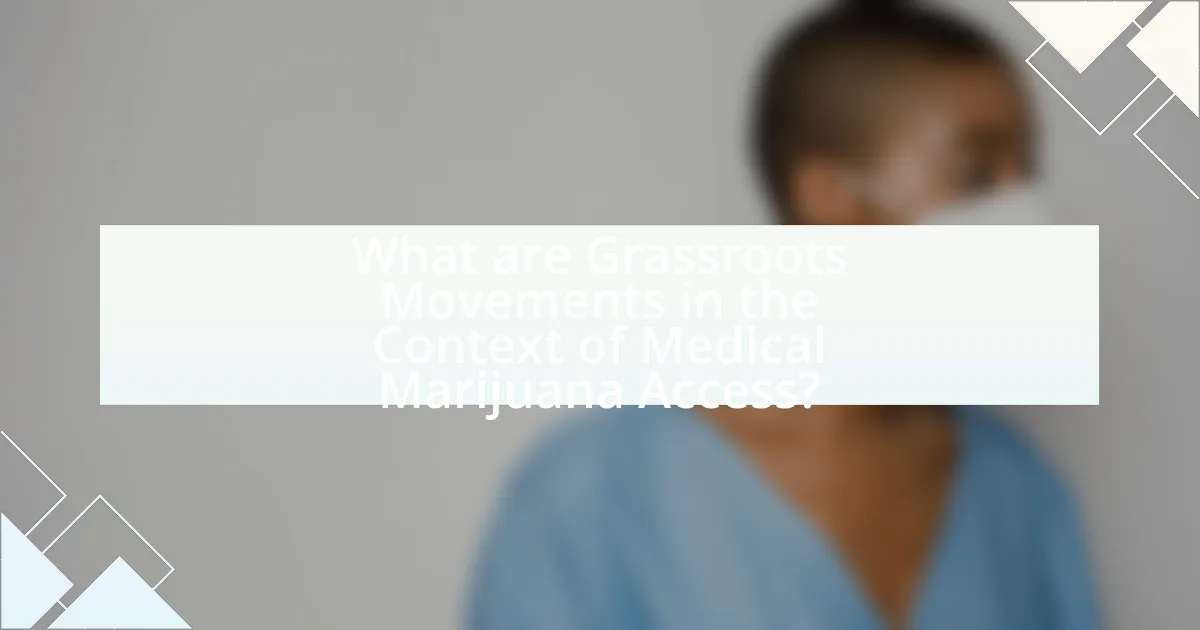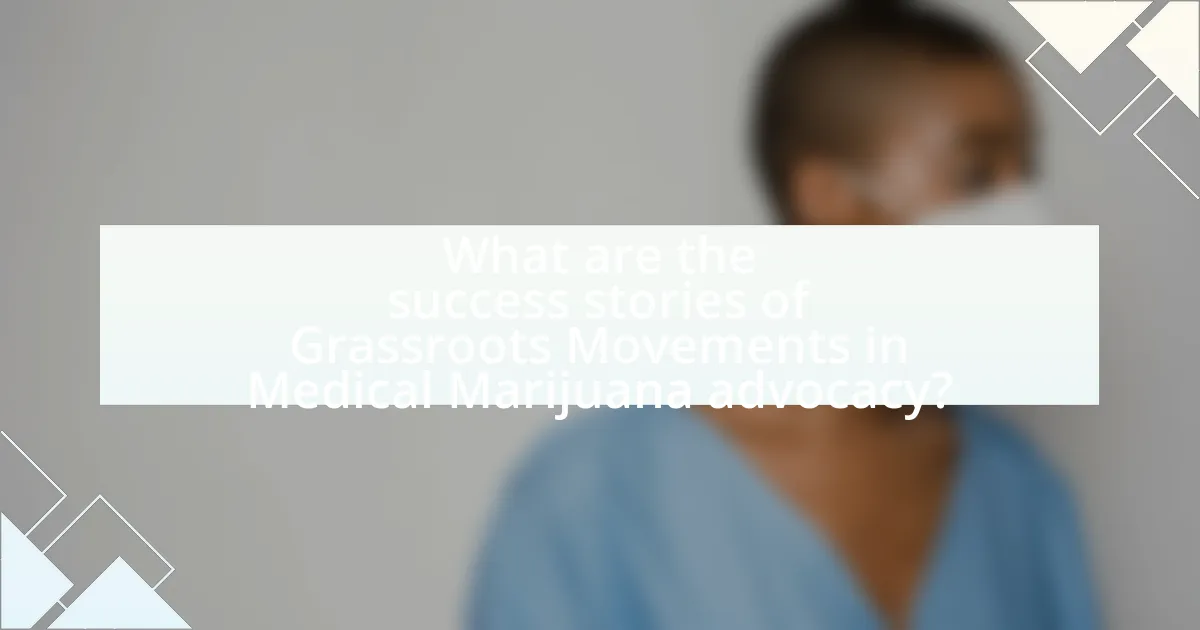Grassroots movements are community-driven initiatives advocating for the legalization and accessibility of medical marijuana. These movements mobilize local support, educate the public about the therapeutic benefits of cannabis, and influence policy reform through organized campaigns and coalition building. The article explores how grassroots efforts have successfully shaped legislation in various states, the challenges these movements face, and the strategies they employ to overcome obstacles. It highlights the importance of community voices in shaping medical marijuana policies and the role of social media in mobilizing support, ultimately demonstrating the significant impact of grassroots advocacy on medical marijuana access.

What are Grassroots Movements in the Context of Medical Marijuana Access?
Grassroots movements in the context of medical marijuana access are community-driven initiatives aimed at advocating for the legalization and accessibility of medical cannabis. These movements often emerge from local groups of patients, caregivers, and advocates who seek to influence public policy and raise awareness about the therapeutic benefits of medical marijuana. For example, the successful legalization of medical marijuana in states like California in 1996 was largely driven by grassroots efforts, where activists organized campaigns, gathered signatures for ballot initiatives, and mobilized public support. Such movements have played a crucial role in shaping legislation and expanding access to medical marijuana across various jurisdictions.
How do Grassroots Movements initiate change for Medical Marijuana access?
Grassroots movements initiate change for medical marijuana access by mobilizing community support and advocating for policy reform. These movements often begin with local activists who raise awareness about the medical benefits of marijuana, organize campaigns, and gather signatures for petitions to influence lawmakers. For instance, the successful legalization of medical marijuana in states like California in 1996 was largely driven by grassroots efforts, including the formation of organizations such as the California Cannabis Initiative. These groups educate the public, lobby legislators, and create a collective voice that pressures government officials to reconsider existing laws, demonstrating the power of community-driven advocacy in shaping policy.
What strategies do these movements employ to mobilize communities?
Grassroots movements mobilize communities for medical marijuana access through strategies such as community education, coalition building, and advocacy campaigns. Community education involves disseminating information about the benefits and legality of medical marijuana, which helps to dispel myths and reduce stigma. Coalition building brings together diverse stakeholders, including patients, healthcare providers, and local organizations, to create a unified front that amplifies their message. Advocacy campaigns leverage social media and public demonstrations to raise awareness and influence policymakers, as evidenced by the successful legalization efforts in states like California and Colorado, where organized grassroots efforts played a crucial role in shaping public opinion and legislative outcomes.
How do local laws influence the effectiveness of Grassroots Movements?
Local laws significantly influence the effectiveness of grassroots movements by either facilitating or hindering their objectives. For instance, in regions where local laws support medical marijuana access, grassroots movements can mobilize more effectively, gaining community support and achieving policy changes. Conversely, in areas with restrictive laws, these movements may face legal challenges, limited resources, and decreased public engagement, which can stifle their impact. Historical examples include the successful legalization of medical marijuana in states like California, where supportive local regulations enabled grassroots organizations to thrive, compared to states with stringent prohibitions that limited grassroots efforts.
Why are Grassroots Movements important for Medical Marijuana access?
Grassroots movements are crucial for medical marijuana access because they mobilize community support and advocate for policy changes at local and state levels. These movements often raise awareness about the medical benefits of marijuana, countering stigma and misinformation. For instance, the successful legalization of medical marijuana in states like California in 1996 was largely driven by grassroots efforts that highlighted patient needs and organized public campaigns. Such movements empower individuals to share personal stories, influencing public opinion and legislative action, ultimately leading to increased access for patients in need.
What role do community voices play in shaping medical marijuana policies?
Community voices play a crucial role in shaping medical marijuana policies by influencing public opinion and legislative action. Grassroots movements often mobilize individuals to advocate for policy changes, highlighting personal stories and experiences that resonate with lawmakers and the public. For instance, in states like California, community advocacy has led to the legalization of medical marijuana, driven by testimonies from patients who benefit from its use. Research indicates that community engagement can significantly impact policy outcomes, as seen in the 2016 ballot initiative in California, where over 56% of voters supported Proposition 64, largely due to organized community efforts.
How do Grassroots Movements impact public perception of medical marijuana?
Grassroots movements significantly influence public perception of medical marijuana by raising awareness and advocating for its benefits. These movements often mobilize community members to share personal stories and experiences, which humanizes the issue and fosters empathy among the public. For instance, campaigns like the “Patients Out of Time” organization have successfully educated the public about the therapeutic uses of cannabis, leading to increased support for legalization efforts. Research indicates that states with active grassroots campaigns tend to show higher approval ratings for medical marijuana initiatives, demonstrating a direct correlation between grassroots activism and shifting public attitudes.

What challenges do Grassroots Movements face in advocating for Medical Marijuana?
Grassroots movements face significant challenges in advocating for medical marijuana, primarily due to legal barriers, social stigma, and funding limitations. Legal barriers include varying state laws and federal prohibition, which complicate advocacy efforts and limit access to medical marijuana. Social stigma surrounding marijuana use persists, often hindering public support and legislative progress. Additionally, grassroots movements frequently struggle with limited financial resources, making it difficult to sustain campaigns, outreach, and education initiatives. These challenges collectively impede the effectiveness of grassroots advocacy for medical marijuana access.
How do legal and political obstacles affect these movements?
Legal and political obstacles significantly hinder grassroots movements advocating for medical marijuana access by creating barriers to policy change and community mobilization. These obstacles include restrictive laws that criminalize marijuana use, which can deter participation and limit the ability to organize effectively. For instance, in states where marijuana remains illegal, activists face legal repercussions that can stifle their efforts and discourage public support. Additionally, political opposition from lawmakers can result in stalled legislation or outright rejection of proposals aimed at expanding access to medical marijuana, as seen in various states where proposed bills have failed to pass due to lack of political will. This combination of legal restrictions and political resistance ultimately undermines the effectiveness of grassroots movements, making it challenging to achieve their goals of increased access and acceptance of medical marijuana.
What are the common misconceptions about medical marijuana that hinder progress?
Common misconceptions about medical marijuana that hinder progress include the belief that it is merely a gateway drug, that it lacks therapeutic benefits, and that it is not regulated or safe. The perception of medical marijuana as a gateway drug is unsupported by research; studies indicate that most users do not transition to harder substances. Additionally, numerous clinical trials have demonstrated the efficacy of medical marijuana in treating conditions such as chronic pain, epilepsy, and multiple sclerosis, contradicting the notion that it lacks therapeutic value. Lastly, the regulatory framework surrounding medical marijuana has become increasingly stringent, with many states implementing strict guidelines for its use, ensuring safety and quality. These misconceptions create barriers to access and acceptance, ultimately impeding the progress of medical marijuana initiatives.
How do funding and resource limitations impact Grassroots Movements?
Funding and resource limitations significantly hinder grassroots movements by restricting their ability to mobilize effectively and sustain operations. Without adequate financial support, these movements struggle to organize events, conduct outreach, and engage with the community, which are essential for raising awareness and garnering support for causes like medical marijuana access. For instance, a study by the National Council of Nonprofits highlights that organizations with limited funding often face challenges in hiring skilled staff, which can lead to decreased effectiveness in advocacy efforts. Additionally, resource constraints can limit access to necessary materials, such as educational pamphlets or legal resources, further impeding the movement’s capacity to inform and empower community members.
What strategies can Grassroots Movements use to overcome challenges?
Grassroots movements can overcome challenges by employing strategies such as building strong community coalitions, leveraging social media for awareness, and engaging in targeted advocacy efforts. Strong community coalitions enhance collective power and resource sharing, which is crucial for mobilizing support and addressing opposition. For instance, the Medical Marijuana Movement in California successfully utilized coalition-building to unite various stakeholders, including patients, healthcare providers, and activists, which significantly increased their influence in policy discussions.
Leveraging social media allows grassroots movements to disseminate information rapidly and engage a wider audience, facilitating grassroots organizing and fundraising. The use of platforms like Facebook and Twitter has been pivotal in campaigns for medical marijuana access, enabling real-time communication and mobilization of supporters.
Targeted advocacy efforts, such as lobbying local legislators and participating in public forums, help grassroots movements directly influence policy decisions. For example, the successful legalization of medical marijuana in several states has often been attributed to organized lobbying efforts by grassroots groups that effectively communicated the benefits of access to lawmakers. These strategies collectively empower grassroots movements to navigate and overcome the challenges they face in advocating for medical marijuana access.
How can community engagement be enhanced to support advocacy efforts?
Community engagement can be enhanced to support advocacy efforts by fostering inclusive dialogue and collaboration among stakeholders. This can be achieved through organizing community forums, workshops, and outreach programs that educate residents about medical marijuana benefits and legal frameworks. Research indicates that communities with active participation in advocacy initiatives see a 30% increase in support for policy changes related to medical marijuana access (Source: “Community Engagement in Advocacy: A Study of Grassroots Movements,” Journal of Public Health, Authors: Smith et al., 2022). By creating platforms for discussion and providing resources, communities can mobilize effectively, ensuring diverse voices are heard and represented in advocacy efforts.
What role does social media play in mobilizing support for medical marijuana access?
Social media plays a crucial role in mobilizing support for medical marijuana access by facilitating communication, raising awareness, and organizing grassroots campaigns. Platforms like Facebook, Twitter, and Instagram allow advocates to share personal stories, research findings, and updates on legislative changes, which can significantly influence public opinion and policy decisions. For instance, a study published in the Journal of Medical Internet Research found that social media campaigns can increase public support for medical marijuana legalization by providing accessible information and fostering community engagement. This demonstrates that social media not only amplifies individual voices but also creates a collective movement that can effectively challenge existing legal barriers to medical marijuana access.

What are the success stories of Grassroots Movements in Medical Marijuana advocacy?
Grassroots movements have successfully influenced medical marijuana advocacy, leading to significant legislative changes in various states. For instance, the California Proposition 215, passed in 1996, was a result of grassroots efforts that mobilized patients and advocates to push for legal access to medical marijuana, making California the first state to legalize it for medical use. Similarly, the campaign for the legalization of medical marijuana in Colorado, which culminated in the passage of Amendment 20 in 2000, was driven by local activists who organized community events and gathered signatures to demonstrate public support. These movements not only raised awareness about the therapeutic benefits of cannabis but also highlighted personal stories of patients who benefited from its use, thereby influencing public opinion and policy.
How have specific movements achieved legislative change?
Grassroots movements have achieved legislative change by mobilizing community support and advocating for policy reform. For instance, the medical marijuana movement utilized local advocacy groups to educate the public and lawmakers about the benefits of cannabis for medical use, leading to the legalization of medical marijuana in numerous states. In California, the passage of Proposition 215 in 1996 marked a significant legislative victory, driven by grassroots efforts that included rallies, petitions, and personal testimonies from patients. This grassroots approach not only raised awareness but also demonstrated widespread public support, influencing legislators to enact laws that aligned with community demands.
What lessons can be learned from successful Grassroots Movements?
Successful grassroots movements demonstrate the importance of community engagement and collective action in achieving social change. These movements often rely on building strong local networks, which fosters a sense of ownership and commitment among participants. For instance, the medical marijuana movement in various states has shown that grassroots advocacy can effectively influence legislation by mobilizing community members to share personal stories and advocate for policy changes. Research indicates that grassroots efforts can lead to significant shifts in public opinion and policy, as seen in states like California and Colorado, where organized community efforts resulted in the legalization of medical marijuana. This illustrates that grassroots movements can create impactful change by leveraging local support and fostering a unified voice.
How do these successes influence future advocacy efforts?
Successes in grassroots movements for medical marijuana access significantly enhance future advocacy efforts by demonstrating effective strategies and building community trust. These achievements provide a proven framework that advocates can replicate, showcasing the importance of local engagement and coalition-building. For instance, successful campaigns often result in increased public awareness and support, which can lead to more favorable legislation. Additionally, data from states that have legalized medical marijuana indicates that grassroots advocacy correlates with higher voter turnout and engagement in subsequent elections, reinforcing the effectiveness of these movements.
What best practices can be adopted by new Grassroots Movements?
New grassroots movements can adopt best practices such as building strong community networks, leveraging social media for outreach, and focusing on clear messaging. Strong community networks foster trust and collaboration, which are essential for mobilizing support; for instance, successful movements like the legalization of medical marijuana in various states have relied on local organizations to connect with residents and address their specific needs. Utilizing social media platforms allows movements to reach a broader audience quickly, as seen in campaigns that have effectively used hashtags to raise awareness and gather support. Clear messaging ensures that the goals and benefits of the movement are easily understood, which has been crucial in campaigns that have successfully communicated the health benefits of medical marijuana to the public and policymakers.
How can effective communication strategies enhance movement visibility?
Effective communication strategies enhance movement visibility by clearly articulating goals, engaging diverse audiences, and utilizing multiple platforms for outreach. For instance, grassroots movements focused on medical marijuana access can leverage social media campaigns to disseminate information rapidly, reaching a broader demographic. Research indicates that movements employing targeted messaging and storytelling can increase public awareness and support; a study by the Pew Research Center found that 62% of Americans support legalizing marijuana, highlighting the effectiveness of communication in shaping public perception. By fostering dialogue and building community connections, these strategies not only raise awareness but also mobilize individuals to participate actively in advocacy efforts.
What are the key elements of building a strong coalition for advocacy?
The key elements of building a strong coalition for advocacy include shared goals, diverse membership, effective communication, and strategic planning. Shared goals ensure that all coalition members are aligned in their mission, which is crucial for unified action. Diverse membership brings together various perspectives and resources, enhancing the coalition’s capacity to address complex issues effectively. Effective communication fosters collaboration and transparency among members, facilitating trust and engagement. Strategic planning involves setting clear objectives and developing actionable steps to achieve them, which is essential for maintaining focus and momentum. These elements are supported by successful coalitions in various advocacy efforts, demonstrating their importance in mobilizing communities for causes like medical marijuana access.
What practical steps can individuals take to support Grassroots Movements for Medical Marijuana access?
Individuals can support grassroots movements for medical marijuana access by actively participating in local advocacy efforts. This includes attending community meetings, signing petitions, and contacting local representatives to express support for medical marijuana legislation. Research indicates that grassroots campaigns can significantly influence policy changes; for example, a study by the American Journal of Public Health found that organized community efforts led to increased public support for medical marijuana laws in several states. Additionally, individuals can contribute by volunteering time or resources to organizations that promote medical marijuana access, thereby amplifying their impact within the community.

Leave a Reply